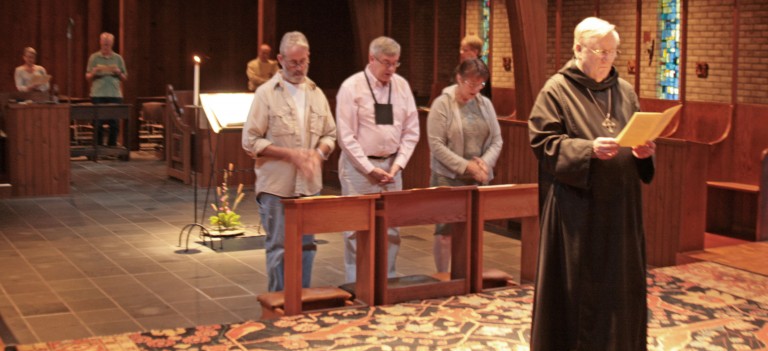From St. Gregory's Abbey Letter...
Monastery churches are not exactly public buildings, nor are they private buildings. They are not parish churches (usually), nor are they retreat center chapels. They are places for monastic communities to gather for corporate prayer, but they almost all have spaces for people who are not members of the monastic community to join in the prayer. Even most of the public prayer that goes on in monastery churches is not the usual style of worship that goes on in parish churches, and the furnishings are not what one finds in a normal church building. Our church has an area where guests sit, and it has a space for our celebration of the Eucharist (an altar or holy table, lectern for public scripture reading, and chairs for those presiding and assisting at the Eucharist). In between the guest area and the altar, however, is where the particularly monastic furniture resides. We monks sit in rows facing each other, perpendicular to the guest seating area. That facilitates our monastic corporate prayer of reciting psalms in antiphonal form (one side recites one verse, the other the next verse, than back to the first side for the next verse, etc.)
The monks sit in “choir stalls” (a seat with a desk for holding the psalm books). These choir stalls are very special places in the lives of nuns and monks. At many monasteries, including here at St. Gregory’s, choir stalls are “assigned seating” (as are our spots in the refectory and chapter room). We sit according to our seniority in the community, and we occupy our particular choir stall until a gap is made in the order above us (by the death or departure of someone ahead of us in seniority). That means that we might be in the same choir stall for years or decades. They become a place where prayer can be cultivated by the occupant; they are often used for private prayer as well as the daily round of corporate prayer.
As the years roll on praying for the many requests we receive, in addition to chanting the same psalms at the same time on the same day every week, we are freed from the notion that our prayer should reflect our own whims and desires, allowing us to open up to allow the Holy Spirit to pray through us. We join in the prayer of all those around the world who have prayed before us and all who will pray after we are long gone. We are held together by the Holy Spirit inside all of us and surrounding us. We learn that our prayer is not about us and does not depend on us, so we never have to worry about “getting it right”. This is all amazingly freeing. We are in a communion of saints who hold us in prayer as we hold others in prayer. We do not and cannot understand our relationship with each other in this communion, but we can live in it and depend on it. We can be at all times and all places with all these others to whom we are joined in prayer.
One does not have to be a monk to have one’s own spot to cultivate prayer. It does help to be stable in one’s prayer time and place, but the important thing is the desire to pray and the honest effort to make oneself available to the Holy Spirit. Any effort is met by grace and is initiated by grace. — Br. Abraham
(You can find it here.)

No comments:
Post a Comment